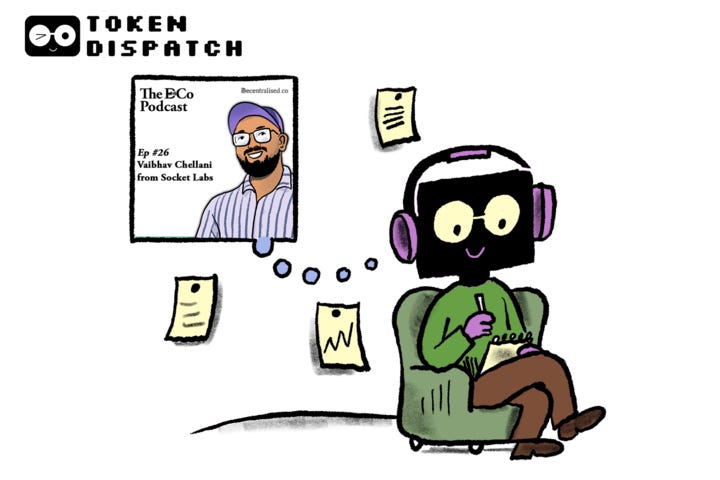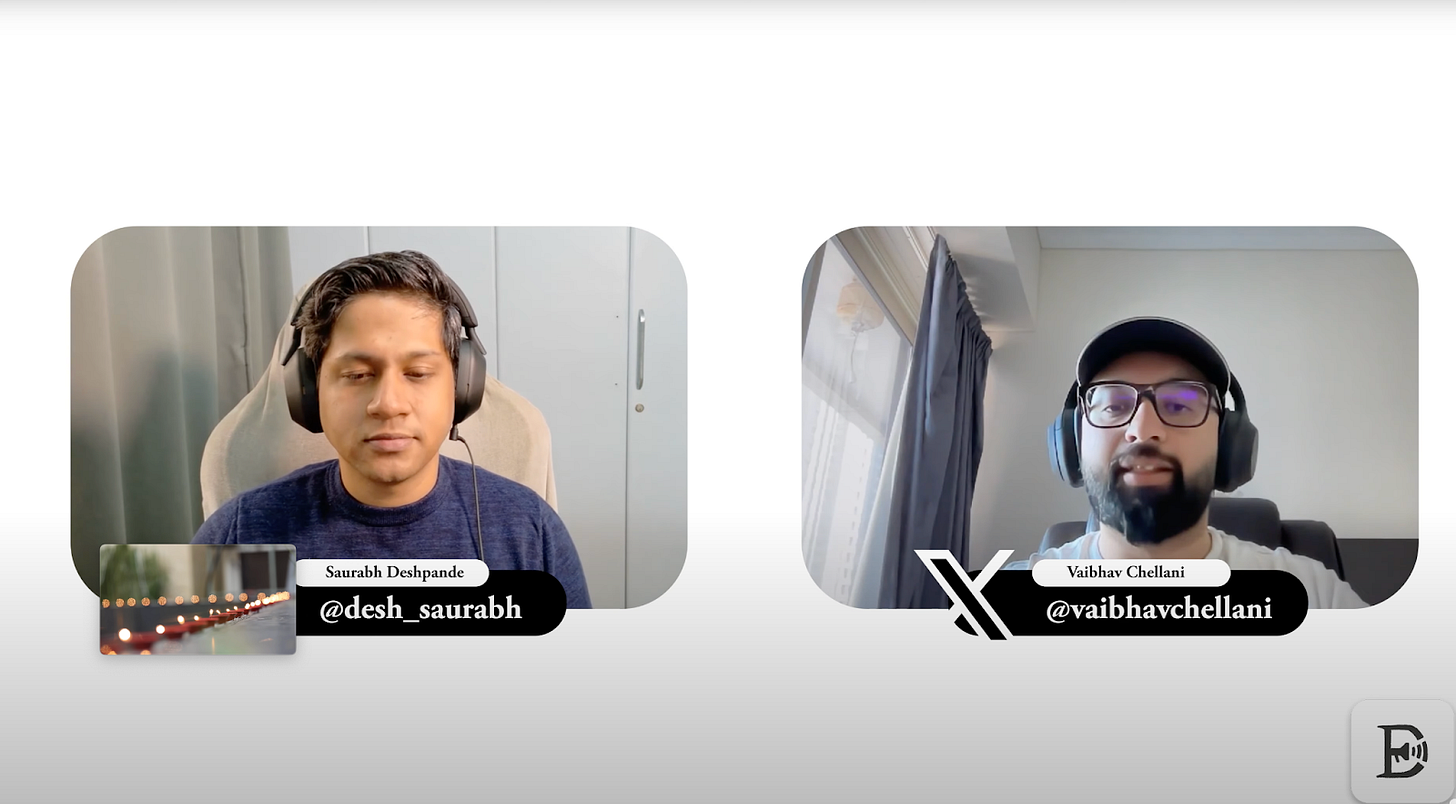Hello
Every week, I sit down with my mug of chai and cue up a DCo podcast hosted by Saurabh Deshpande for our partners at Decentralised.co. For almost four months now, it’s become my weekly ritual. For one hour, I listen to builders solving problems in Web3, then share my takeaways with our retail readers at Token Dispatch.
This week’s reflections focus on the episode featuring Vaibhav Chellani, co-founder of Socket, the protocol aiming to make cross-chain deposits as simple as a single tap.
Have you used Polymarket recently? Notice what it doesn’t do when you are kicking off your prediction market journey. No nagging you for not having enough gas fee in a particular chain. Doesn’t demand a specific token. It doesn’t swarm you with half a dozen wallet addresses based on chain or asset. It makes life easier and decision-making simpler for someone who’s there just to monetise their predictions on real-life events.
But how did Polymarket achieve this? And why do we need more of this? I will write about it in today’s piece.
Want the unfiltered breakdown from the builder’s side, including how Vaibhav stumbled upon this route and how it remains capital-efficient? It’s in the episode.
Give it a watch. 👇🏾
Unlock Web3 Insights with Decentralised.co
Long-form stories trusted by the best in Web3. Senior executives from 140+ enterprises trust them to keep them updated on what’s going on in crypto.
Good writing. In-depth conversations. Right in your inbox.
Subscribe to Decentralised.co
I often find this issue with Web3 products. Builders romanticise complexities and expect users to figure out their way around the product. I don’t think this approach is effective, especially if the goal is to achieve widespread adoption.
This absence of friction, as seen in the case of Polymarket, is rare in the crypto space. You come across these friction points every day in crypto. Think of topping an NFT marketplace on Polygon to buy a new digital art collection. You have plenty of USDC, but the wallet asks for MATIC to pay the gas fee. Now you need to swap and bridge just to pay a few cents. The irony is that for the user, this swap-and-bridge process has nothing to do with the actual transaction of heading to the marketplace to buy an NFT. Often, this friction is what makes the difference between gaining and losing an additional user.
I loved how Vaibhav put this: users come on-chain to access assets. Not to navigate and solve the puzzle that on-chain complications throw at them.
Polymarket’s one-address deposit is the proof. It allows users to start their journey from a single point. The infrastructure then takes care of all the dirty work in the background: swapping, bridging and settling the asset where it needs to be.
The closest comparison is how my forex card worked during my recent trip to Thailand. I could swipe it anywhere, and it would settle the transaction at a competitive exchange rate. I had another international card I could have used to withdraw the local currency, but that would have required me to go around asking for the best exchange rate. My forex card just let me tap while the infrastructure handled the rest.
Crypto has trained us to do the opposite.
We don’t worry about which submarine server carries the data packets that help us stream the Sunday night live F1 race. Then why am I required to worry about which chain is servicing my on-chain lending protocol? Or why should I search for the route that will charge me the least gas fee or the chain that will provide the least latency?
While the thought had been in my mind for a while, what Vaibhav said reinforced it further: “Bridging shouldn’t be an application. Users shouldn’t have to think about bridging. It’s like an underlying pipe, just like (the internet’s) TCP/IP protocol, which users don’t need to interact with.’’
This brings me to another point that has stuck with me - the role of AI agents in resolving these complications.
I want to be able to tell my AI agent to buy some BONK using funds from whichever is the cheapest wallet among all my connected on-chain wallets, without worrying about which chain or bridge to use. The agent would know my preferences, avoid the bridges I distrust, and weigh fees before triggering a deposit intent. This is not a far-fetched expectation. We already use traditional off-chain platforms that optimise user experience across navigation and transaction security.
I expect crypto to follow the same lead. Why should my crypto app require me to micromanage every transaction?
This is why I believe Vaibhav’s Socket is addressing a genuine problem. Socket’s consumer-facing product, Bungee, doesn’t leave it to the users to decide between a dozen bridges and swaps. Instead, it presents a single route that’s already optimised for speed, cost, and reliability. It abstracts the complicated decision-making process into a simple action: I type what I want to send and where I want it to land, and the system takes care of the rest.
Every bridge selection screen is a point of hesitation for new users. Crypto needs to stop looking at its users as engineers.
There’s a lot more to the crypto infrastructure that Vaibhav spoke about, including the modular order flow auctions (MOFA), capital efficiency, and rollup routing tips. I will leave that for the episode. 👇🏾
What I take away from this is that if crypto builders are aiming for wider adoption, then they need to make their products feel more user-friendly.
That’s it for this week’s reflections. I’ll see you next week.
Off to bet on some prediction market trades,
Prathik
Token Dispatch is a daily crypto newsletter handpicked and crafted with love by human bots. If you want to reach out to 200,000+ subscriber community of the Token Dispatch, you can explore the partnership opportunities with us 🙌
📩 Fill out this form to submit your details and book a meeting with us directly.
Disclaimer: This newsletter contains analysis and opinions of the author. Content is for informational purposes only, not financial advice. Trading crypto involves substantial risk - your capital is at risk. Do your own research.







Polymarket streamlining the UX is a great example of “real world” blockchain utility coming to the forefront, especially when people are hungry for alternatives to old systems. My recent writeup covers why urgent, user-friendly innovation is pushing Bitcoin/web3 to new highs—would value your feedback: https://beyondthecoin.substack.com/p/bitcoin-hits-122k-while-us-government